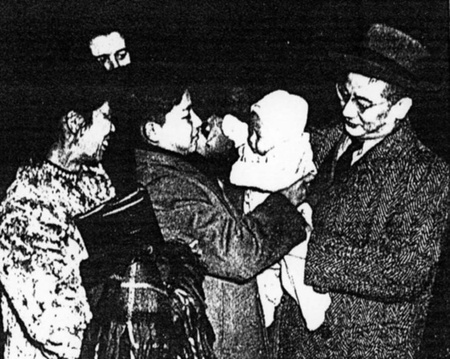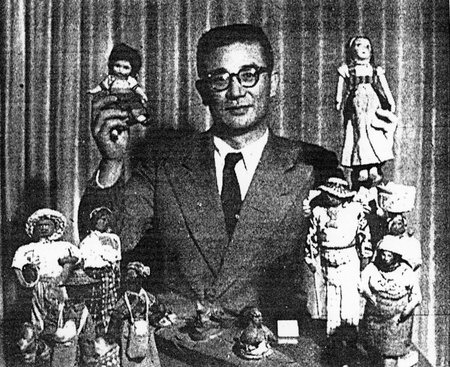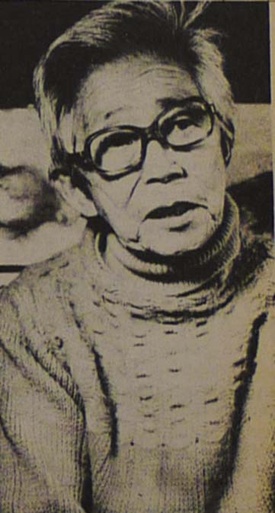One remarkable Japanese American story is that of the epic and tragic partnership of Taro and Mitsu Yashima, an extraordinary couple of artists and freedom fighters. Together they survived years of hardship—imprisonment, exile, poverty, and illness—and made a name for themselves as authors and illustrators. Eventually they reached a point where Mitsu was unable to continue with her husband.
Taro Yashima was born Jun Atsushi Iwamatsu on September 21, 1908, the son of a doctor and art collector in the seaside town of Nejime (now part of Minami Ōsumi-cho), in Kagoshima prefecture. Yashima later recalled that his childhood was happy. "My parents' house was full of patients," he recalled, remembering his father's medical practice. "When the people were cured, they were happy toward my father.”
From his boyhood, Yashima demonstrated a passion for art. At age 13, he published satirical manga in the Kagoshima Shimbun newspaper(later known as Minami Nihon Shimbun.) At age 19, he entered the Tokyo Academy of Fine Arts in Ueno (now the Tokyo National University of Fine Arts and Music). However, as a pacifist, he refused to participate in the military training course required in all Japanese schools, and was expelled from art school for insubordination. Instead of changing schools, he became active in anti-fascist activities, and joined the Japanese Proletarian Artists’ League, where he taught drawing and became involved with his future wife.
Born Tomoe Sasako in Innoshima in 1908, Mitsu Yashima was the daughter of a shipbuilding engineer. Despite her father’s managerial position, she early developed sympathy for the shipyard workers who went on strike to protest company cutbacks. She attended Kobe College, a Christian girls’ school, then enrolled at the Tokyo women’s college Bunka Gakuin. Attracted by the student arm of Japan’s Communist Party, which led resistance to Japan’s ruling military clique, she joined the “research institute” of the Art Students League.
The two artists married in 1930, and began working together in political organizing. They painted farmers and laborers and arranged exhibitions of art that critiqued military expansion and the growing repression of dissent. Taro, in particular, was arrested nine times for anti-government activities over the next three years. The official harassment climaxed in 1933 when both partners were incarcerated, each in a six-foot square cell with 5 to 15 other prisoners. As Taro later recounted, both were tortured while in prison. Mitsu, who had lost her first-born son and was now again pregnant, feared losing the baby. Ultimately they were released, but only after signing “confessions” in which they disavowed their political activities. Two months later, in December 1933, Mitsu gave birth to their son Makoto, known as Mako.
In the following years, they lived comfortably with Mitsu’s family in Kobe. While they reduced their more visible political activism, Taro produced numerous cartoons in the political-economic monthly Keizo and other publications satirizing the militarists. Eventually they decided to leave Japan, which was dominated by the militarists and moving toward war. In 1939, they received visas to travel to the United States, on the pretext of visiting the San Francisco World’s Fair and writing about life in America. Leaving Mako behind with his grandparents, they left Japan and went into exile in New York.
The Iwamatsus settled in Manhattan, where both enrolled at the Art Students League. They faced dire poverty, living in a cold-water flat in East Harlem (sleeping on the floor for weeks until they could secure a single mattress) and working to scratch out a living. Mitsu did art piecework, painting soap dispensers and other accessories for department stores. Taro scrounged through wastepaper baskets for art materials. In desperation, he attempted to organize a Koen-kai (organization of sponsors) within the city’s Japanese community. However, due to his pro-democratic reports from North America in Keizo, he was opposed by the pro-Tokyo community leadership. His efforts to enlist help from the Consul-General, Commercial Attaché, and the head of the Japan Institute met with unanimous refusal. However, both spouses were offered patronage by editor Shigetsu Sasaki, who commissioned artwork (including fashion sketches of hats) for the New York Shimpo and the Japanese American Review and solicited support from others.
After the Japanese attack on Pearl Harbor, the couple were hired as free-lancers for the new Office of War Information. They took the pseudonyms Taro and Mitsu Yashima in order to shield their families in Japan from reprisals. Taro Yashima also joined the antifascist organization Japanese American Committee for Democracy and organized a JACD blood drive. In 1943 he published his first book, The New Sun, a graphic memoir of his imprisonment in Japan that detailed his and his wife's mistreatment by Japanese secret police. Yet he also hoped to convey in the book what he considered his message to Americans at the time: that all Japanese were not "wild monkeys." While The New Sun was widely and positively reviewed, and even taken up by the Office of War Information as a tool in the war against Japan, it sold poorly. In 1944, together with fellow artists Miné Okubo and Yasuo Kuniyoshi, he contributed drawings for Fortune magazine’s special issue on Japan. The issue was so successful that the government organized an exhibition tour of the artworks.
Soon after, the Yashimas were hired by the Office of Strategic Services, believing, Mitsu wrote, “we could study the best way to stop the war.” Under OSS auspices, Mitsu was sent to San Francisco, becoming possibly the first Japanese alien permitted to settle in California during World War II. At first, she experienced overt racism, and had difficulty securing housing. During her stay, she produced and narrated radio broadcasts urging the women of Japan to commit sabotage and do what they could to stop Japan’s military machine. While Mitsu worked as “America’s Tokyo Rose” (as she was later termed), Taro was sent to India on intelligence missions. Upon his return, he wrote and illustrated handbills in Japanese for dropping over battlefields, bearing the phrases "Don't Die!" and "Papa, Stay Alive." Later he would be attacked in Japan as a traitor, to which he responded that his sole aim was to save Japanese lives. "At the time it was easy to say I was one who was against his own country," he explained. "That's the most terrible thing, because my feeling was, I'm doing it because I love my country."
Yashima was in India with OSS on V-J Day. Soon after, he went on an OSS mission to Japan, which he had not visited since 1939, with the U.S. strategic bombing survey team. According to his later account, Yashima had seen films of bombing raids on Kobe, during which he saw his studio — where his son and parents were living — riddled by bullets from a fighter plane. For years he was unaware whether his family was alive or dead. Although the house was indeed ruined, Yashima located his 12-year old son, who was in good health.

Following Yashima’s release from government service, both partners’ legal status in the United States remained uncertain. With sponsorship from their superiors in OWI and OSS, a special bill was enacted in Congress in 1948 to permit both spouses permanent residence in the United States, as a reward for their wartime work. They were also granted permission to bring Mako to the United States. He arrived in 1949, shortly after the birth of the Yashimas’ daughter Momo. Soon after, Mako joined the U.S. Army, and was thereby able to gain citizenship. After his discharge, Mako became a celebrated stage and screen actor, and was nominated for an Oscar for his performance in the 1966 film The Sand Pebbles.
Once the war ended, both Yashimas threw themselves into writing and art. Both began working for the Chicago Shimpo, edited by progressive Issei Ryochi Fujii. Mitsu contributed an essay on “Women in Japan,” while Taro produced a regular Japanese-language column, “Taro’s Miscellany,” which discussed art, literature, and democracy. He also wrote a play based on the Momotaro legend. Both helped found an art group, the Japanese-American Art studio, which held an exhibition of their joint work. During these years, the Phillips Collection in Washington D.C. bought three of Taro’s paintings. The couple spent summer 1950 at the artists’ colony Yaddo. That fall, Taro had his first postwar solo exhibition, showing 30 paintings at the 65th Avenue gallery.
Meanwhile, the Yashimas produced their most significant joint production, Horizon is Calling, a sequel to The New Sun. Although Mitsu was not credited as an author, her contribution is tangible in the descriptions of her family, as well as the narrator’s sensual, loving description of playing with baby Mako and his beautiful nude form.
Ironically, once the long trauma that the Yashimas had undergone ended and the family was reunited, the emotional time bomb within Taro finally exploded. "I held everything inside," he later recalled. "When it was all over, I couldn't keep it any longer." He developed a crippling ulcer and was largely unable to work. Stuck at home, he grew close to his daughter Momo, who provided him needed companionship and joy during his lengthy recovery. The stories that he recounted to her inspired him to pursue children’s book writing and illustration as a career. His first picture book, The Village Tree (1953), was followed by Crow Boy (1955), Umbrella (1958), and Seashore Story (1967), among others. Mitsu and Taro co-authored Plenty to Watch (1954) and Momo’s Kitten (1961)—the timing of the joint productions suggests that Mitsu may have been an uncredited collaborator on the others. Taro ultimately won three Caldecott Honor Book Awards and received a 1974 prize from University of Southern Mississippi for outstanding contribution to children's literature.
In 1954, the Yashimas moved to Los Angeles, settling in the Boyle Heights district. They established the Yashima Art Institute, where both initially taught. However, due to differences in their personalities and teaching styles, Mitsu again turned to art piecework to support the family, painting bath accessories that Mako would deliver to stores such as Robinson’s and the May Company. By the 1960s, after Momo graduated high school and left the house, the couple separated. Taro’s physical abuse of his wife, which had persisted for many years, had grown intolerable for Mitsu, who left him and moved to San Francisco. In the following years, Taro continued producing children’s books and worked as artist and educator. He was commissioned to paint a mural for a Southern California public library. In 1965, he did scene and costume design for a production of the Japanese classic Rashomon that Mako produced for the new Asian American theater company East/West Players.Taro Yashima suffered a stroke in 1977 and died in Los Angeles in 1994.
Once in San Francisco, Mitsu devoted herself to art and community work. She established herself as a lecturer at UC Berkeley, on "People's Art in Japan." During the 1970s she taught art, creative writing and swimming at Kimochi, a Japanese American senior center. Mitsu — having never forsaken her activism — joined the Women Strike for Peace movement against nuclear weapons and the Vietnam War. She also attended the Vancouver Indo-Chinese Women’s Conference in 1971 as a member of the Asian American delegation. She made her screen debut in the 1976 TV-movie Farewell to Manzanar, acting opposite her son and daughter. She illustrated the children’s book Tobei: A Japanese Folktale (1974).
Part of Mitsu’s legacy was her involvement in the San Francisco Japan Town Art Movement; she became an influential leader in the Japantown Art & Media Workshop, inspiring younger activists. She said, “Art should make people feel good, sometimes it should make them angry.” Her portraits of friends, neighbors, and Vietnamese caught up in the war reflect this belief. In 1980, the Japanese American Citizens League held a solo exhibition of her art at their national headquarters. In later years, her health declined. At the urging of her children she moved back to Los Angeles in 1983 and lived with Momo until her death in 1988.
© 2018 Greg Robinson; Valerie J. Matsumoto








